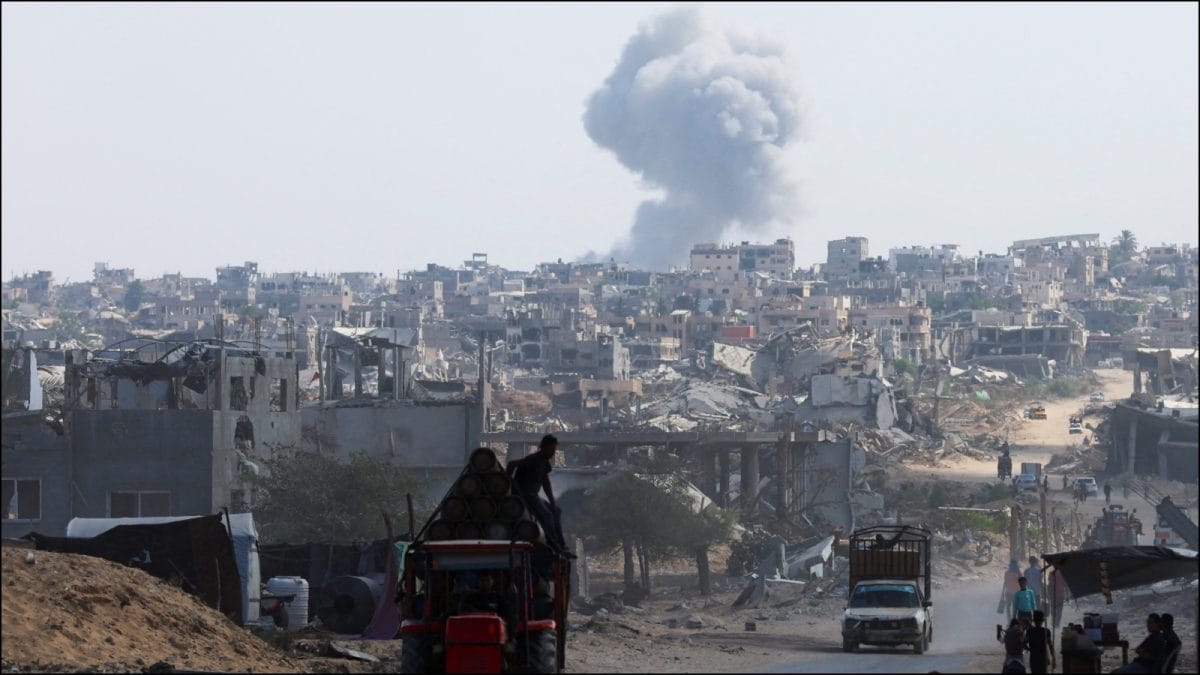Last Updated:October 30, 2025, 15:18 IST
Around the world and across India, cyclones are no longer the rare, seasonal disturbances they once were. They are now stronger, faster, and far costlier.

The Bay of Bengal has traditionally produced the majority of India’s cyclones, but the Arabian Sea has seen a worrying surge (Image: Canva)
Tropical cyclones, massive rotating storm systems driven by warm ocean waters have always been among nature’s most destructive forces. But in recent years, both scientists and disaster management agencies have noticed a change.
While the total number of cyclones has not increased dramatically worldwide, their intensity, rainfall, and speed of intensification have risen sharply. This means that when storms form, they are more powerful, more destructive, and harder to predict.
Global Picture: Storms Are Packing More Power
According to the United States Environmental Protection Agency (EPA), the number of hurricanes and tropical cyclones making landfall each year has not shown a consistent increase since the late 19th century. However, the average energy and destructive potential of these storms have clearly risen since the 1990s.
The EPA’s “Climate Change Indicators: Tropical Cyclone Activity" report notes that the Accumulated Cyclone Energy (ACE) and Power Dissipation Index (PDI) two key measures of storm strength – have trended upward, reflecting storms that are lasting longer and reaching higher wind speeds.
Climate scientists attribute this to warmer sea surface temperatures and higher humidity in the atmosphere, which feed more energy into storms. A study by the Geophysical Fluid Dynamics Laboratory projects that cyclone intensity could increase by 4 percent and rainfall rates by up to 15 percent later this century as global temperatures rise.
These changes may sound small, but in practice they can transform a category-2 storm into a category-3 or category-4 system within hours.
Damage and Economic Losses
The human and economic toll of these stronger storms has been staggering. In the United States alone, tropical cyclones caused more than US $1.5 trillion (about Rs 12 lakh crore) in damage between 1980 and 2024. The average loss per event is now around US $23 billion (about Rs 1,840 crore).
A growing proportion of these storms have also undergone “rapid intensification"—a phenomenon where wind speeds increase by more than 55 kilometres per hour in just 24 hours. This leaves communities with little time to prepare.
Globally, tropical cyclones, hurricanes, and typhoons are responsible for some of the costliest weather disasters every year. The combination of higher wind speeds, heavier rainfall, and storm surges amplified by rising sea levels has made them particularly damaging to coastal economies. Scientists caution that this is not just about climate variability but a consistent signal of warming oceans.
Why Cyclones Are Getting Stronger
There are several interconnected reasons why modern cyclones are more dangerous than those of past decades.
Warmer seas: Ocean temperatures above 26.5 degrees Celsius act as fuel for cyclones. Every additional degree of surface warming provides more latent heat, helping storms intensify faster.More moisture: A warmer atmosphere holds more water vapor, which means heavier rainfall and higher flood risk.Rising sea levels: Global sea level rise, now averaging about 3.4 millimeters per year, increases storm-surge damage during landfall.Rapid intensification: Modern storms are hitting their peak just before landfall, giving emergency responders less time to act.Together, these factors explain why storms are not just stronger but also more unpredictable, a combination that makes them especially dangerous in densely populated regions such as South and Southeast Asia.
The Indian Scenario: A Decade of Cyclone Challenges
The North Indian Ocean, which includes the Bay of Bengal and the Arabian Sea, has long been one of the world’s most active cyclone basins. India, with its 7,500-kilometer coastline and large coastal population, is particularly vulnerable.
The Indian Meteorological Department (IMD) records around five to six cyclones forming in this region each year, but what has changed recently is their severity and geographic spread. The Arabian Sea, which historically saw fewer strong storms, has become more active over the last decade.
Between 2015 and 2025, India has witnessed roughly 25 cyclones that either made landfall or caused major damage along its coasts. Some of these were among the strongest storms ever recorded in the basin.
Dr G S Srinivasa Reddy, former Director of the Karnataka State Natural Disaster Monitoring Centre (KSNDMC), explained to News18 that the growing intensity of cyclones is closely tied to climate change and global warming.
“Rising pollutant levels in the atmosphere cause temperature fluctuations, trapping greenhouse gases and creating more zones of low pressure and high heat. This imbalance, doesn’t just stay in the air – it seeps into the earth and oceans. Groundwater levels are affected because higher temperatures demand more energy to pump water, while sea surface temperatures have risen sharply, providing excess heat energy that fuels stronger and more frequent cyclones" he said.
Major Cyclones and Their Impact on India
Cyclone Vardah (2016): Struck Tamil Nadu and Andhra Pradesh in December 2016. Caused damage worth about Rs 22,573 crore (US $2.8 billion).
Cyclone Ockhi (2017): Affected Kerala, Tamil Nadu, and Gujarat. Claimed over 250 lives and caused losses exceeding Rs 8,000 crore (US $1 billion).
Cyclone Titli (2018): Made landfall in Odisha. Damage was estimated at Rs 2,700 crore (US $330 million).
Cyclone Fani (2019): One of the strongest cyclones to hit Odisha in two decades. Caused damage worth about Rs 65,000 crore (US $8.1 billion).
Cyclone Amphan (2020): A super-cyclone that devastated parts of West Bengal and Bangladesh. Damage was estimated at Rs 1.12 lakh crore (US $14 billion), making it one of the costliest storms in Asian history.
Cyclone Nisarga (2020): The first severe cyclone to strike Maharashtra in over a century. Damage estimated at Rs 6,400 crore (US $803 million).
Cyclone Nivar (2020): Hit Tamil Nadu and Puducherry in November. Damage stood at around Rs 4,000 crore (US $480 million).
Cyclone Tauktae (2021): Ravaged the Gujarat coast and parts of Maharashtra. The Disaster Management Authority estimated losses of over Rs 15,000 crore (US $1.9 billion).
Cyclone Yaas (2021): Made landfall near Odisha and West Bengal. Losses were around Rs 6,000 crore (US $730 million).
Cyclone Biparjoy (2023): A long-lived system in the Arabian Sea that struck Gujarat. Damage was estimated at between Rs 8,000 and Rs 10,000 crore (US $970 million to US $1.22 billion).
Cyclone Michaung (2023): Made landfall near Andhra Pradesh in December and flooded Chennai. Losses were pegged at Rs 8,500 crore (US $1 billion).
Cyclone Remal (2024): Landfall between India and Bangladesh in May, heavily impacting West Bengal. Damage around Rs 2,000 crore (US $240 million).
Cyclone Montha (2025): The first major storm of 2025, striking near Kakinada in Andhra Pradesh. Early estimates suggest damage exceeding Rs 1,000 crore (US $120 million).
The Cost of Rising Intensity
India’s cyclone death tolls have declined over the decades thanks to better forecasting, evacuation systems, and disaster management. However, the financial and infrastructural damage has increased sharply. Coastal states like Odisha, West Bengal, Gujarat, and Tamil Nadu face repeated economic shocks that can erase years of development gains.
A study by the Institute of Disaster Management estimated that cyclones cost India an average of Rs 13,000 crore (US $1.6 billion) annually. With urbanization and industrial zones expanding along coastal belts, future storms could drive even larger losses. The World Bank has warned that by 2050, coastal flooding and cyclones could threaten assets worth over Rs 20 lakh crore (US $250 billion) in India.
Changing Patterns Across Coasts
The Bay of Bengal has traditionally produced the majority of India’s cyclones, but the Arabian Sea has seen a worrying surge. Warmer waters there are now sustaining severe cyclones like Tauktae and Biparjoy, which would have been rare twenty years ago.
Scientists from the Indian Institute of Tropical Meteorology note that the frequency of very severe cyclones in the Arabian Sea has increased by about 50 percent in the past decade.
This means states like Maharashtra, Kerala, and Gujarat, which earlier considered themselves relatively safe, are now frontline regions in India’s cyclone map.
Preparing for the Future
The trend is unmistakable: cyclones are becoming stronger, wetter, and more erratic. India’s response has improved, but infrastructure resilience remains a challenge.
The government’s Cyclone Risk Mitigation Project has reduced fatalities, yet long-term planning must now focus on climate adaptation, coastal zoning, and resilient housing.
Investing in early warning systems, green buffers like mangroves, and strict enforcement of building codes can cut future losses. Insurance coverage, which remains low among Indian households and small businesses, also needs expansion to spread risk more equitably.
Around the world and across India, cyclones are no longer the rare, seasonal disturbances they once were. They are now stronger, faster, and far costlier. Data from the U.S. Environmental Protection Agency, the Indian Meteorological Department, and disaster management agencies all point to one conclusion: climate-driven ocean warming is amplifying the power of storms.
In India, the shift is already visible in the costliest storms of the past decade—from Amphan and Fani on the east coast to Tauktae and Biparjoy on the west. Each one shows that preparedness, not complacency, is the only defence. The question now is not whether cyclones will come, but how ready we will be when they do.
First Published:
October 30, 2025, 15:18 IST
News explainers Are Cyclones Getting Stronger? A Global Shift And India’s Rising Risk
Disclaimer: Comments reflect users’ views, not News18’s. Please keep discussions respectful and constructive. Abusive, defamatory, or illegal comments will be removed. News18 may disable any comment at its discretion. By posting, you agree to our Terms of Use and Privacy Policy.
Stay Ahead, Read Faster
Scan the QR code to download the News18 app and enjoy a seamless news experience anytime, anywhere.


 6 hours ago
6 hours ago

















